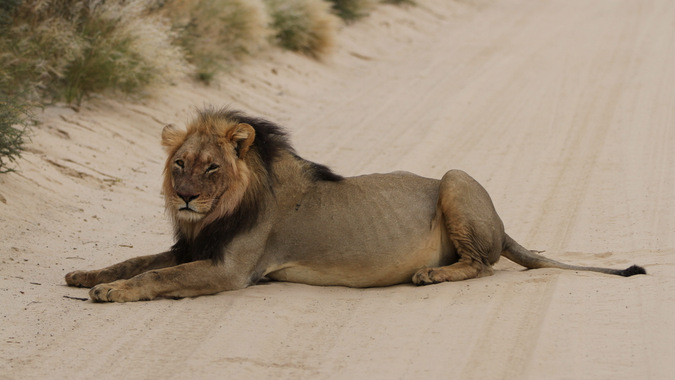
Lions are threatened across their natural range, and the Kgalagadi Transfrontier Park (KTP) straddling South Africa and Botswana is a stronghold for the species.
A research project, conducted during 2013-2015 and published in April 2017, resulted in a population estimate of 246 (237–256) lions (most precise of three count methods) in the southwestern sector of KTP, which is higher than previous estimates.
Summary
A 30% population decline and 80% range reduction over the past 20 years has resulted in there being fewer than 20,000 wild lions remaining in Africa, across 65 natural populations. Ten of these natural populations are considered strongholds – and KTP is one of these ten strongholds.
Small populations of animals that are subjected to high rates of human persecution, such as Africa’s lions, have a greater likelihood of extinction, and so understanding trends in population size, age and sex is important.
Previous research over the preceding 40 years suggested a relatively stable Kalahari lion population of 517 lions in the entire KTP, but research in 2010 off a small sample suggested a male bias of 56%, compared to previous research reflecting a female bias of 58%.
The aim of this research, therefore, was to reduce uncertainty as to population size and key variables.

The research was conducted in the dune savanna semi-desert of the southwestern sector of KTP. The area of 14,250 km² covered the Kalahari Gemsbok National Park in South Africa and a buffer strip to the east, in the Gemsbok National Park in Botswana. The researchers drove 49,784 km over 26 months, with 317 days of sampling. They counted 261 individual lions, from 1,162 sightings (of which 1,022 could be identified), and recorded 11 deaths. Of the identified lions, 74 were cubs born during the survey period.
Three methods of counting were utilised, producing the following results:
1. Mark-recapture: 246 (237-256) lions
2. Track indices: 242 (176-307) lions
3. Registration study (after removing known deaths): 250 lions
The report includes a detailed discussion about each of the three methods, including shortcomings and inaccuracies.
The full report: African Journal of Wildlife Research, B. Otto Beukes, Frans G.T. Radloff, Sam M. Ferreira.: “Estimating African lion abundance in the southwestern Kgalagadi Transfrontier Park”

To comment on this story: Login (or sign up) to our app here - it's a troll-free safe place 🙂.![]()
HOW TO GET THE MOST OUT OF AFRICA GEOGRAPHIC:
- Travel with us. Travel in Africa is about knowing when and where to go, and with whom. A few weeks too early / late and a few kilometres off course and you could miss the greatest show on Earth. And wouldn’t that be a pity? Browse our ready-made packages or answer a few questions to start planning your dream safari.
- Subscribe to our FREE newsletter / download our FREE app to enjoy the following benefits.
- Plan your safaris in remote parks protected by African Parks via our sister company https://ukuri.travel/ - safari camps for responsible travellers






